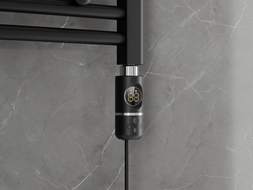
The concealed shower system is gaining more and more supporters among interior designers and users. It is also recommended by installers, especially in newly built bathrooms or during major renovations of interiors. Hiding some elements increases the attractiveness of the room and creates unlimited arrangement possibilities. How to properly carry out the installation and ensure its long-term, trouble-free usage?
Start with the pipes supplying water
Installation of the concealed shower system requires prior chipping of grooves in the wall, so it can be used in newly built bathrooms or during their thorough renovation. This work should be done before laying the tiles. The external parts will be installed after all finishing work is completed. Before the actual installation, a hole should be chiseled in the wall where the mixing element of the concealed faucet will be placed. Its size and depth must match the dimensions of the faucet. This way, we will ensure the possibility of freely placing the concealed element and provide access to the pipes supplying water.
Pipes used in water installations usually have a diameter of 15 or 20 mm. They can be made of plastic, steel, or copper. The first ones are resistant to corrosion and limescale, lightweight and easy to install, but they have low resistance to high temperatures and quick aging of the material. The recommended metal for such installations is copper, which—in contrast to steel—is characterized by durability, bacteriostatic properties, resistance to corrosion, and high pressure. Unfortunately, the quality comes with a high price for copper.
Ensure that each concealed element is in its place
After placing the pipes and water mixer in the wall grooves, the connections to the remaining elements of the shower system are led, i.e., the spout, shower head, rain shower, or any hydromassage jets. The ends of the hot and cold water pipes should be brought to the exact height at which we want to have the faucet. Typically, the knob or lever of the shower faucet is set at the height of an elbow-bent arm. For an average adult height, this is between 110 cm and 130 cm above the floor. The average height of the shower head is about 180 cm from the floor surface.
Naturally, one does not have to rigidly adhere to the provided recommendations, but rather adjust the installation location to the height of the users. If the household members are tall and it is more convenient for them to use the fixtures mounted at a greater height, nothing stands in the way of installing them higher than the generally accepted norms. However, if persons with disabilities, moving in wheelchairs, use the shower, it is necessary to take into account the individual predispositions and limitations of these individuals. In such cases, both the faucet and the rain shower should be lowered.
Check the tightness of the shower system using water
After connecting all receivers, before sealing the grooves and holes, it is necessary to ensure that the installation has been properly made. If everything is in order, we can proceed to check the tightness of the pipes. First, we test using cold water. After filling the installation with water, we check the tightness of all connections, the completeness of the caps, and the absence of condensation on the valve glands. After a positive test with cold water, the installation is then subjected to a test with water at a temperature of 60°C.
A positive test result allows for the completion of the installation of the concealed elements. We can then plaster the grooves, hiding the pipes and connections in the wall, and subsequently lay the tiles. The final stage is placing decorative covers on the exposed connections and sealing them with silicone, as well as equipping the interior of the shower cabin with external, functional elements of the fittings.
Take care of the proper maintenance of shower elements and enjoy user comfort
The majority of concealed systems available on the market enable hassle-free replacement and maintenance of worn parts without the need for wall chipping. The most prone to failure products include shower heads, hoses, and rain showers. Therefore, it is important to choose high-quality products from well-known brands that offer warranty service. The shower head, rain shower, and hydromassage jets should feature an anti-calc system, which prevents limescale buildup, thus extending their lifespan and reliability.
In the case of issues with the thermostatic faucet, it most often involves damage to the regulator. This part can be easily removed and replaced with a new one. The aerator located in the spout also requires periodic inspection. If you notice a decrease in water flow, check if it needs cleaning or replacement.
An essential factor determining the durability and comfort of using the concealed installation is its proper maintenance. The fittings should be cleaned with mild caring agents, avoiding products with abrasive particles, rough sponges, or aggressive cleaning agents containing, for example, chlorine. Improper maintenance risks scratching chrome surfaces and may result in the loss of warranty.



















